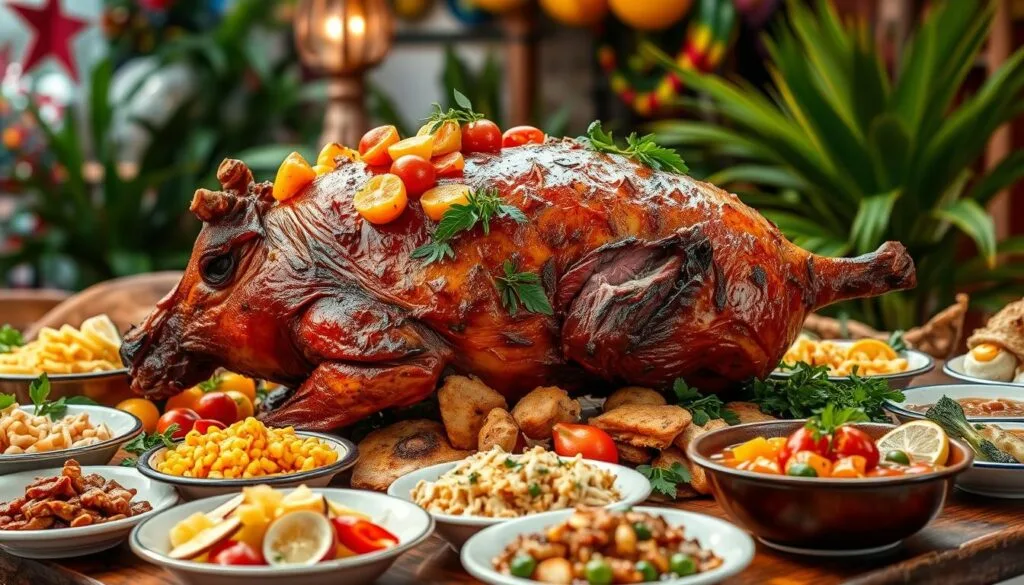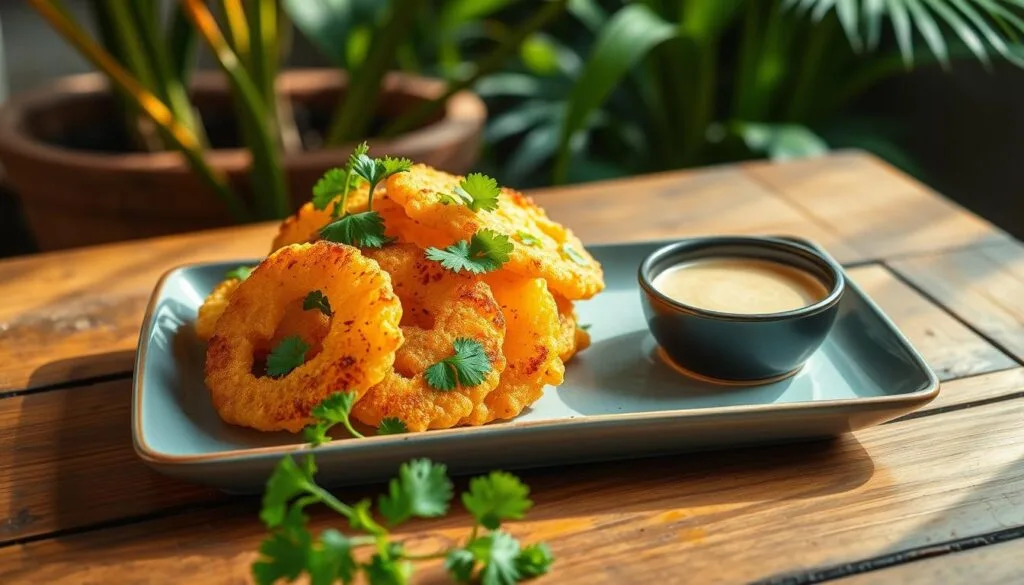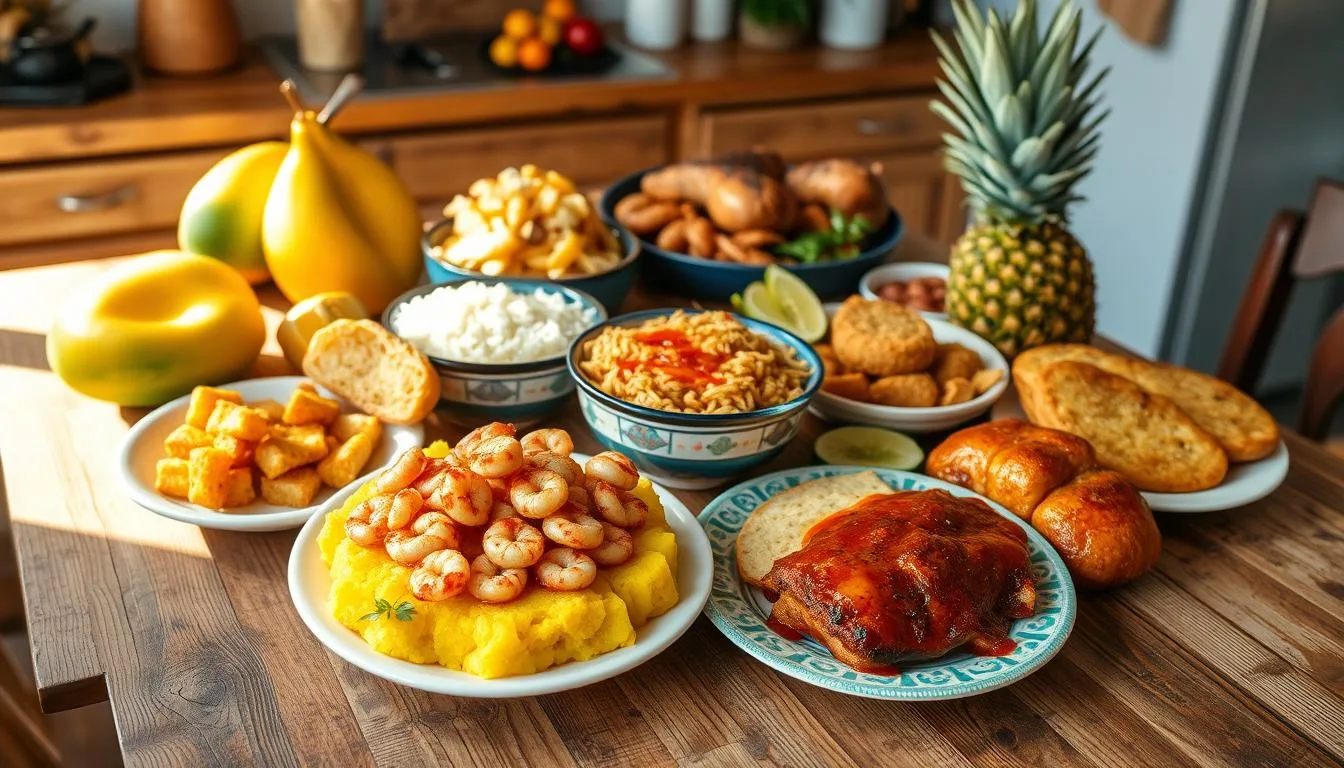Puerto Rico is a treasure trove of culinary delights. Its food culture is a mix of Taíno, Spanish, and African traditions. This article will explore the top Puerto Rican foods you must try.
Mofongo, made with plantains and crispy pork skin, is iconic. Arroz con gandules, a rice dish with pigeon peas and sofrito, is comforting. Roast pork, or lechón asado, is a highlight of celebrations. Pastelón, a plantain lasagna, shows the versatility of plantains.
Beyond savory dishes, Puerto Rico’s culinary heritage includes delightful fritters like alcapurrias and bacalaitos. Asopao, a soupy rice dish, is heartwarming. Don’t miss the sweet tembleque, a creamy coconut pudding, and the traditional Christmas drink, coquito.
Join us as we explore the vibrant flavors and rich cultural heritage of Puerto Rican cuisine, one dish at a time.
Table of Contents
The Rich Culinary Heritage of Puerto Rico
Puerto Rican cuisine is a mix of many cultures. It has been shaped by the Taíno people, Spanish colonizers, and African influences. This blend of traditions makes Puerto Rican food unique and delicious.
Influence of Indigenous, Spanish, and African Traditions
The Taíno people introduced cassava, sweet potatoes, maize, and tropical fruits to Puerto Rico. Christopher Columbus’s arrival in 1493 brought Spanish influence with rice, wheat, olives, and spices. The slave trade also shaped Puerto Rican food, adding plantains, yams, okra, and cooking methods like deep frying and stewing.
Celebration of Flavors and Community
Puerto Rican food is more than just food. It celebrates the island’s history, community, and love for tasty dishes. Traditional cooking and family meals are key to the culture. Dishes like arroz con gandules and mofongo unite people and honor the island’s culinary heritage.
The first Puerto Rico Wine & Food Festival in 2025 will highlight the island’s food culture. It will celebrate the diverse culinary influences. The festival will promote local products and offer educational experiences, preserving Puerto Rico’s unique flavors and traditions.
Mofongo: The Iconic Plantain Dish
Mofongo is a key dish in Puerto Rico and loved worldwide. It shows the rich flavors and heritage of Puerto Rican food.
Preparation and Versatility
Green plantains are the base of mofongo. They’re fried and mashed with garlic, chicharrones (crispy pork skin), and olive oil. This mix offers a perfect balance of textures and tastes.
Mofongo is great because it can be enjoyed many ways. You can have it alone, with broth, or with meat like steak or shrimp. Its flexibility makes it a favorite in Puerto Rico.
A Comforting and Satisfying Staple
Mofongo is not just food; it’s a comfort for many in Puerto Rico. Its history, influenced by the island’s cultures, makes it a cherished puerto rican plantain dish. It’s a key part of puerto rican comfort food.
“Mofongo is more than just a dish – it’s a cultural expression, a taste of home, and a celebration of the flavors that define Puerto Rican cuisine.”
Arroz con Gandules (Rice with Pigeon Peas)
Arroz con gandules is a vibrant rice dish loved in Puerto Rican cuisine. It combines rice, pigeon peas, and a fragrant sofrito. This mix celebrates the island’s culinary traditions.
The pigeon peas, or gandules, give a nutty flavor and a nice texture. The sofrito adds rich, aromatic tastes. It’s often served at festive times, showing Puerto Rican hospitality.
The recipe makes 8 servings and takes about 50 minutes to prepare. It has a 4.6 out of 5 rating from 133 votes. This shows its popularity among rice dish fans.
Each serving has 441 calories, 77g of carbs, 9g of protein, and 10g of fat. It also has 5g of fiber and only 1g of sugar. It’s a good source of calcium and iron, making it nutritious.
Leftovers can be stored in the fridge for up to 5 days or frozen for 3 months. When reheating, add 2 teaspoons of water to keep the rice moist and flavorful.
Authentic arroz con gandules includes ham or bacon. It’s cooked in a caldero, a traditional pot. The key ingredients are rice, pigeon peas, sofrito, tomato sauce, and chicken bouillon paste. Seasonings like adobo, sazón, garlic powder, cumin, and cilantro are also used.
| Ingredient | Quantity |
|---|---|
| Long grain rice | 2 cups |
| Pigeon peas (gandules) | 1 (15-ounce) can, drained |
| Sofrito | 1/2 cup |
| Tomato sauce | 1 (8-ounce) can |
| Chicken bouillon paste | 2 tablespoons |
| Adobo seasoning | 1 teaspoon |
| Sazón seasoning | 1 teaspoon |
| Garlic powder | 1/2 teaspoon |
| Ground cumin | 1/2 teaspoon |
| Chopped fresh cilantro | 2 tablespoons |
Arroz con gandules is Puerto Rico’s national dish. It celebrates the island’s rich culinary heritage and the joy of sharing meals. This vibrant rice dish is a must-try for those exploring Puerto Rican cuisine.
Lechón Asado: The Celebrated Roast Pork
At the heart of Puerto Rican cuisine is the famous lechón asado. It’s a dish loved for gatherings and celebrations across the island. This slow-roasted pork shows the rich culinary heritage of Puerto Rico. It brings together indigenous, Spanish, and African flavors for a unique dining experience.
Slow-Roasted over Open Flames
Making lechón asado is a labor of love. It starts with a careful marinade of garlic, oregano, salt, and vinegar. The whole pig is then roasted over open flames for hours.
The result is juicy meat with a crispy, golden-brown skin. It’s so tender, it just melts in your mouth.
A Centerpiece for Gatherings and Celebrations
The lechón asado is more than a dish; it’s a symbol of Puerto Rican culture and community. It’s the star of many puerto rican celebratory dishes and puerto rican communal feasts. Families and friends come together to enjoy good food, lively talks, and make memories.
The smell of the slow-roasted pork is irresistible. It invites everyone to join in the feast and enjoy the rich flavors of this beloved tradition.

“The lechón asado is not just a dish, but a symbol of Puerto Rican culture and community.”
Pastelón: A Unique Twist on Lasagna
In Puerto Rico, a dish named pastelón shines brightly. It’s a mix of flavors and traditions. Instead of pasta, it uses fried plantains.
The base of pastelón is the plantain. These fruits are sliced thin, fried, and layered with ground beef. The beef is seasoned with olives, raisins, and spices. This mix of sweet plantains and savory beef is a true puerto rican fusion cuisine and puerto rican comfort food blend.
This puerto rican plantain lasagna shows Puerto Rico’s creativity. It uses local ingredients and draws from many cultures. Pastelón is a symbol of the island’s rich culinary history, proving that great flavors can come from simple things.
“Pastelón is a true celebration of the vibrant flavors and traditions that make Puerto Rican cuisine so captivating. It’s a dish that reminds us of the power of culinary creativity and the ability to transform the ordinary into the extraordinary.”
Pastelón is perfect for family dinners or big celebrations. It lets us enjoy the rich flavors of puerto rican cuisine. From the first bite, it takes you straight to Puerto Rico’s lively heart.
Alcapurrias and Bacalaitos: Delightful Fritters
Puerto Rico’s street food is known for its variety and taste. Alcapurrias and bacalaitos are two favorites. They mix indigenous, Spanish, and African flavors, showing the island’s rich history.
Alcapurrias: Savory Plantain Fritters
Alcapurrias are fritters with a dough of green bananas and yautía. They’re filled with seasoned ground beef or crab. This mix of textures and tastes is a Puerto Rican specialty.
Bacalaitos: Crispy Codfish Fritters
Bacalaitos are thin, crispy fritters from salted codfish, flour, and spices. Soaking the cod in water overnight is key for the right flavor. They’re fried to a crunchy perfection, loved by many.
Enjoying alcapurrias and bacalaitos is a treat. They’re perfect for a quick snack or a big meal. Their flavor and convenience bring a taste of Puerto Rico to you.
“Alcapurrias and bacalaitos are more than just snacks – they’re a testament to the ingenuity and creativity of Puerto Rican cuisine, blending traditional ingredients and techniques in a delicious and portable form.”
Asopao: A Heartwarming Soupy Rice
In Puerto Rican cuisine, asopao is a dish that warms the soul. It brings families together. This thick, savory rice stew is a favorite puerto rican comfort food on cool, rainy days. It’s seasoned with sofrito, garlic, and spices, offering a taste of the island’s rich heritage.
Asopao is versatile, with each version showing the cook’s personal touch. Some add puerto rican stew ingredients like pigeon peas. Others highlight local seafood flavors. Yet, it always nourishes both body and spirit.
A Comforting Meal for Rainy Days
On rainy days, asopao is the top choice for Puerto Ricans. It’s a mix of rice, flavorful broth, and sometimes chicken, pork, or seafood. This combo is perfect for cold weather.
Asopao is more than just a meal. It’s a symbol of Puerto Rican resilience and community. It brings people together, offering a taste of home and the island’s rich culinary heritage.
“Asopao is the ultimate comfort food in Puerto Rico, a true reflection of our warmth and hospitality.”
Tostones: Twice-Fried Plantain Perfection
Puerto Rico’s food scene is rich with amazing dishes, and tostones are a top favorite. These crispy, golden plantain slices mix the island’s cultural roots. They blend indigenous, Spanish, and African traditions into a tasty snack or side dish.
Tostones, also known as patacones, start with green plantains. First, they’re sliced into thick rounds and soaked in garlic and salt water. This first fry makes them tender for the next step.
After frying once, the slices are flattened. This can be done with a tostonera or a glass. It turns the soft inside into a crispy outside, making tostones so tasty.
The plantains are then seasoned with salt. They’re often served with mayo ketchup or ajillo. These sauces add a rich flavor that complements the tostones perfectly.
Tostones are a favorite snack in Puerto Rico. They’re great with pernil and churrasco. You can also find them at puestos (street food stalls) around the island.
Enjoying tostones alone or with other Puerto Rican dishes is a treat. Their sweet taste and crunchy texture are a must-try for anyone exploring Puerto Rico’s flavors.

“Tostones are a quintessential Puerto Rican dish that capture the essence of the island’s culinary traditions. The combination of crisp, golden-brown plantain slices and flavorful dipping sauces creates a truly irresistible experience.”
Puerto Rican Foods: A Sweet Indulgence
Puerto Rican cuisine is known for its vibrant flavors. It’s not just the savory dishes that are amazing. The island also has a variety of sweet treats, like tembleque and coquito.
Tembleque: The Creamy Coconut Pudding
Tembleque is a creamy coconut pudding loved by many. It’s made with cornstarch and coconut milk, giving it a silky texture. A sprinkle of cinnamon adds a touch of sweetness.
Coquito: A Tropical Twist on Eggnog
Coquito is a festive holiday drink with a tropical twist. It’s made with coconut milk, condensed milk, and rum. Spices like cinnamon and nutmeg add warmth to this beloved drink.
These puerto rican desserts show the island’s rich culinary traditions. They blend Indigenous, Spanish, and African influences. Tembleque and coquito are just a few examples of Puerto Rico’s vibrant flavors and community.
Exploring the Vibrant Flavors of Puerto Rican Cuisine
Puerto Rican cuisine is more than food; it’s a celebration of the island’s history and culture. Each dish shares a story of the island’s diverse influences and the creativity of its people. From the comforting mofongo to the vibrant arroz con gandules, it invites you to experience a rich tapestry of flavors and traditions.
These traditions have been passed down through generations. Whether you’re enjoying a street food delicacy or a family-style feast, you’re part of a long-standing tradition.
From Street Food to Family Gatherings
Puerto Rican cuisine reflects the island’s vibrant food culture. It offers a wide array of dishes, from beloved street food staples to treasured family recipes. Indulging in the crispy delight of tostones or savoring the creamy sweetness of coquito takes you to the heart of Puerto Rican culinary traditions.
A Culinary Journey Through the Island’s Traditions
The iconic lechón asado (roast pork) is a star at celebrations. The comforting asopao warms the soul on rainy days. Puerto Rican cuisine is a tapestry of flavors that celebrate the island’s rich culinary heritage.
Explore the diverse array of Puerto Rican street food, like the savory alcapurrias and bacalaitos. Or indulge in the decadent Puerto Rican family recipes, like the creamy tembleque and the festive coquito.
Dive into the vibrant world of Puerto Rican cuisine. Discover the rich tapestry of flavors that have been woven into the fabric of the island’s culture, traditions, and community.
Conclusion
Exploring puerto rican cuisine opens a window into the island’s rich culture and people’s spirit. From mofongo to tembleque and coquito, each dish tells a story. These foods celebrate the island’s history, community, and love for tasty meals.
The puerto rican cuisine is a mix of Spanish, African, and Taino flavors. It offers a unique and exciting taste experience. Enjoying dishes like alcapurrias and asopao, you’ll learn about Puerto Rico’s strength, cultural exchange, and people’s pride.
Discovering puerto rican food takes you on a journey of flavors that connect you to the island’s heart. From beaches to mountains, Puerto Rico’s food invites you to celebrate life and community. It shows why this place is truly special.

